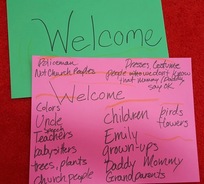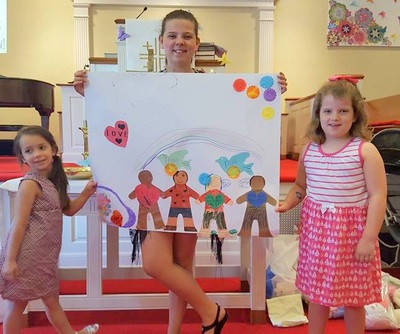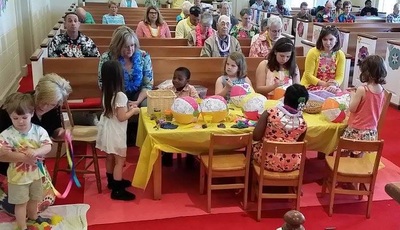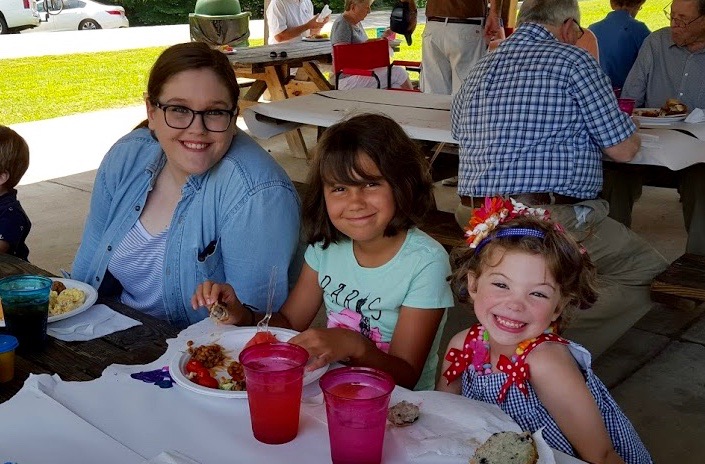 I was hosting a webinar recently and mentioned a Holy Week Fair we offered for our children and families last year. Our church traditionally hosts the Easter Egg Hunt on Palm Sunday, and I wanted to offer a little more faith formation around it. This fair is best for kids 3- 12 years old. It's written with multiple stations that are best set up in different rooms, but can be adapted for a single space or even outdoors. It really depends on your space. Be creative! All page numbers refer to Growing in God’s Love: A Story Bible Click Here for a PDF of the Directions. Pre-Event, Opening Set Up In largest room, gym, fellowship hall, etc.
First Station - Palm Sunday Obstacle Course this works best in a hallway leading to a room or gathering area at the end Set up
Second Station - Maundy Thursday could be kitchen or classroom near the palm Sunday obstacle course hallway Set -up
Third Station – Gethsemane and Good Friday Classroom, garden, tent, sanctuary Set up
Fourth Station – Easter classroom (can be the same classroom as good Friday), tent outside, garden Set-up
Closing, Egg Hunt
If you feel like adapting even more, I patterned this off of an event I did with my amazing colleague Katie Kinnison in Columbus, Ohio. We offered a three hour VBS-style event on Good Friday for kids and families that was a lot of fun. We called it "Thank God It's Good Friday." It could be great to add more of the stories from Jesus' last week, like the anointing at Bethany (John 12: 1-8), Jesus cursing the fig tree and/or cleansing the temple (Mark 11:12-25).
1 Comment
“Mom! Easter sunrise breakfast!” called my bleary-eyed but excited daughter. Since anticipation is part of the fun, I told her about our new tradition before she went to sleep on Saturday night so she was ready to hold me accountable the next morning. “We’re still doing it, right?”
With two clergy parents serving different churches, Sundays can be a bit hectic for our family. And EASTER Sunday? Well, let’s just say the bunny doesn’t visit our house. He’s too tired. But I want Easter to be special. I want it to be about more than egg hunts and baskets. I want it to be about more than church. I know that sounds strange, but my kids get a LOT of church – and they love it. We love it. We need it. A Christian community that worships, prays, learns and serves together is vital for faith development. But we can’t just read the Bible at church. And my kids need to hear me pray not just at the front of the sanctuary, but at the dinner table and the bedside and even (sometimes) early in the morning, wrapped up in blankets in the front yard. Because the most important faith mentors in the life of a child are not their Sunday School teachers or their youth group leaders or even their pastors. Children learn faith from their families – from their parents and grandparents and all the many beautiful iterations of kinship. Parents, if we want our kids to know God, if we want our kids to love Jesus, if we want our kids to feel the joy of Holy Spirit or learn the holy stories, it’s on us. It’s a big responsibility (even for pastor parents, believe me), and it does require a little thought and effort (even for pastor parents), but it’s not a burden. And it doesn’t have to be hard. God is all around us, and opportunities to weave faith into our daily lives abound. That’s why I love Traci Smith’s new book, “Faithful Families.” She offers simple, powerful practices for all the ordinary and extraordinary moments of family life. From long car rides, interminable rainy days, and mealtime mania to birthdays, new schools, and even times of tragedy and grief, Smith does most of the thinking and a good bit of the work to provide a ceremony, a prayer, a discussion, or an activity to make it holy. Her work is easy to access and adapt to fit the rhythms of different families. If you spend 5 minutes with this book, you’ll find something that makes you say, “we’ve gotta try that!” Easter is a busy day for us, but it doesn’t mean we don’t have time for each other. So we gathered the powdered sugar donuts, mixed the chocolate milk, poured the coffee and set out across the front yard to find the perfect spot to watch the sunrise. “Early in the morning, while it was still dark the women set out for the tomb…” I began the story. “Just like us! It’s early! It’s dark but it’s getting light…” my 4 year old son interrupted. Yes, just like us.  Christmas is coming. All is merry and bright (and a little bit maddening). If you are like me, you are already feeling behind. The house is a mess. The decorations are still in the attic. And I have no idea where to find the Advent calendar. It stayed out until Easter last year... Be not afraid dear ones. Jesus is coming. Here are some practices to center you and your family around the love and light of Christmas:
Jesus is coming. And that's miracle enough. I've had a lot of requests recently for information about how to build or begin Cross-Gen Worship in a church. "How do you do this?" people ask.
The short answer: "by the grace of God." (I'm working on a case study to explore the longer answer and will post in the coming months.) Each congregation, each sanctuary, each worship service has it's own unique gifts and challenges. I don't believe there isn't a set formula for "how to" but I encourage you to pray, dream, and listen to the calling of the Holy Spirit. And also know, I do NOT do this alone. I may be a part-time solo pastor, but I have colleagues and mentors and friends all over the globe whose work inspires, challenges, informs, and contributes to this work. They can be your community too! This is my current resources list for creating worship love. It is by no means exhaustive, so please share your favorite resources with a one sentence note about what makes them wonderful and I'll keep updating the list! Getting Started - blogs, articles, and books for information, education, and inspiration
 We welcome everyone at our church! Even Emily! We welcome everyone at our church! Even Emily! Dear Friendly Church, Many churches struggle to welcome children and their families into worship, but not you! You are flexible and kind when kids get crazy and noisy. You understand the importance of regular worship in the lives and faith of children, and you embrace the gifts they bring to your community. But I notice that while you smile and nod from your pew, you keep a wide berth around those lively worshiping kids. If you have a special worship space for families, it’s often full of kids with nary a (non-staff) adult in sight. That’s okay. I’m guessing you aren’t excited about praying with crayons and play dough (although if you are you NEED to check it out because it’s for anyone who wants to try a hands-on worship experience.) Smiling is a great first step! But it’s time for us all to do more. I encourage you do more than watch from a safe distance and try to interact with the kids during worship. I understand why you hesitate. Maybe it’s been a long time since you’ve talked to a five year old and you don’t know what to say. Maybe you have trouble hearing children’s voices or getting down to their level. Maybe you worry they will be afraid or that they won’t want to talk to you. Or maybe it just never occurred to you to have a conversation with a kid! Let me assure you now, a child may be nervous or shy – he might hide when you try to say hello, she might giggle and run away when you make eye contact – but they DO want to talk to you! You are interesting and kind. You are fun and engaging. You are wise and thoughtful. You care about children and want to teach them about Christ and worship. You are EXACTLY who kids want to meet when they come to church. Sure, it’s fun to play with peers – but most kids spend plenty of time with friends of the same age. Yes, it’s important that the children engage with the pastors and children’s ministry folks. But you have the light of Christ in your heart too, and it’s time to let it shine! We need more adults in the pews with the kids – coloring, singing, praying and listening. This will help the kids engage and learn even more about worship. But you don’t have to change the way you worship to build relationships with kids in your church. When you pass the peace, make sure to talk to at least one child. You might try to join them in for one hymn or for the prayer. Connect with families and kids before or after church. Or one of these ideas for interacting with kids in worship. Our children need to know your name, and you need to know their names. They need to know what you love, whom you love and how you love – and vice versa! You’ve been worshiping alongside one another and it is fabulous! Now it’s time to worship TOGETHER - to pray with each other, to love another, to build the Body of Christ together. So start with “Hi! I’m ___________. What’s your name?” And don’t stop. Keep showing interest and watch the relationships grow! Love, A Friend PS - Try replacing all references to “children,” “kids,” or “families” with VISITORS for encouragement to welcome new folks into your community.  PRO TIP - Dump Legos onto carpet or padded surface BEFORE worship to avoid the tumult of plastic bricks shifting in bins. PRO TIP - Dump Legos onto carpet or padded surface BEFORE worship to avoid the tumult of plastic bricks shifting in bins. A deafening rumble filled the sanctuary. Bricks cascaded against one another and ricocheted off the walls. Towers smashed to the ground and rose from the rubble as playful fingers reveled in order and chaos. It was marvelous mayhem, but very slowly and very loudly, a glorious dwelling began to emerge. Our text for worship was the story of Solomon building the temple, so I encouraged the children to work together to build a house for God out of Legos. It was a great idea! Who knew that tiny plastic bricks could be so LOUD? I raised my voice, my gut twisting as I watched the faces of my congregation. Most strained to hear and stay focused. A few gave up listening to the sermon, but seemed perfectly happy watching the kids build. And of course, some sat arms crossed, eyes rolling, lips pursed, huffing with annoyance at each new crash. (Why is the perfect piece always at the bottom of the bin?) Now you are the body of Christ and individually members of it. – 1 Corinthians 12: 27 In our small but mighty church, we worship together (even when we don't like it) because we are one body—young and old, silent and speaking, calm and fidgeting. We welcome and engage everyone because we need each other. We envision lips singing as only lips can sing while hands lift, grasp, and carry as is their strength. We imagine minds blossoming with wisdom and ears straining for understanding. We see wild, unkempt hair bouncing in the wind of the Spirit and hearts beating in time, pumping the life-blood through this fully engaged body of worship. And it is unspeakably beautiful. And it is terribly hard. We don’t always enjoy the gifts of other members of the body – especially when they differ so vastly from our own. An ear is not made for dancing, so when she listens to the soft thuds and heavy breathing of a body in motion, she doesn’t grasp its joy. A foot is not designed to see, so he doesn’t recognize the glorious interplay of light and shadow through which he walks. But that doesn’t mean we don’t need each other. It doesn’t mean we aren’t part of the same body. It just means we are different—and that’s okay! If the whole body were an elder with a penchant for tradition, where would the sense of adventure be? If the whole body were a frazzled family just trying to get it all done, where would the sense of peace and patience reside? If the whole body were a toddler waving his arms in joy one minute and weeping with frustration the other, God save us. But as it is, God arranged the members in the body, each one of them, as GOD chose. If all were a single member, where would the body be? As it is, there are many members, yet one body. The eye cannot say to the hand, “I have no need of you,” nor again the head to the feet, “I have no need of you.” (1 Cor 12:18-20) We need each other – not just to worship but to survive. As much as we idolize the power of the individual, we build our society with common work and care for one another. A doctor needs a farmer to grow food. A farmer needs a politician to legislate good agricultural policy. A politician needs a teenager to speak truth and make passionate pleas to remember her true calling—to serve the body. Church is one of the few spaces left where people of all ages and experiences stand side by side, where we speak in unison and sing in harmony, where we unite into one body. If we don’t hear, see, touch, and even smell each other, how can we ever hope to connect and experience each other’s gifts? If we don’t share one sanctuary, how can we be knit together by one Spirit? I love the song “One” by U2, but when I looked up the lyrics I realized I was blissfully belting out the wrong words for a key phrase. I sang: “We’re one but we’re not the same. We’ve got to carry each other” – like it’s a burden or a charge we must accept. I sang this line as a call to action, which has its place, but that’s not the lyric. One small word makes all the difference: “We’re one but we’re not the same. We get to carry each other.” It’s not a burden, it’s a gift. To carry another’s heart and to offer yours in turn is a gift. To depend on one another is a blessing. To misunderstand and even grumble, but still love one another is sacred. To join many members in becoming one body is holy. We get to carry each other until that day, that glorious day, when we are truly One. As I offered the charge and benediction to the worshiping body, I held the house the children built for God—a patchwork of color and size, towers and windows, flowers and lions and dinosaurs and people joined into one sacred whole. It didn’t come together silently or easily, but it was beautiful and holy. I looked at faces filling the sanctuary: some radiant, a few disgruntled, all beloved, all connected. Together, we build a dwelling place of the Holy One not out of Legos or cinderblocks, but out of worship and service, out of tears and laughter, out of love for one another and for the world. We are the body of Christ, the church. Thanks be to God. This post originally appeared as "One Body" in Fidelia's Sisters, the online magazine of The Young Clergy Women Project.  the author, giving the universal sign for "quiet please" - Note the smile with closed lips :) the author, giving the universal sign for "quiet please" - Note the smile with closed lips :) Good news! You have children at your church! And if they dart around chattering and giggling, they feel happy and comfortable within your community and your building. Good job church! Of course, these behaviors can be distracting and sometimes dangerous, so here are some tips for supporting kids as they learn how to behave in a church community: Your goal is to problem solve, not punish. If the child is doing something dangerous (like running through a crowded hallway or sliding down a bannister) intervene. Be careful to support, not scold.
 Smile - even if you’re nervous and don’t know how to deal with children, even if you’re annoyed that kids kick the pews, even if you worry the baby may scream and interrupt the sermon, even if you wonder why they didn’t take those kids to the nursery, especially if you are happy they came to church. Because you’ve been blessed with the chance to be like Jesus - to teach and listen and care for the littlest among us. Here’s how:
I gave this 5 minutes talk at the Association of Presbyterian Church Educators conference in January. It's "the story of a little church making space for God to bring new life out of death." It gives a little background into how we began embracing cross generational worship, and also WHY this is bringing new life to our church.  Ash Wednesday Family Image by RubyDW - used with creative common lisence Ash Wednesday Family Image by RubyDW - used with creative common lisence You are dust, and to dust you shall return. The hand moves with careful deliberation - down, then across - a coal black cross marks each head turning back toward the pews. I move forward in line, my body swaying with the rhythm of the murmured promise, my infant daughter babbling quietly against my shoulder. Finally, I stand before my dear friend and she marks my face with the ashes - last year’s hosannas returned as this year’s dust - the cycle life and death contained their oily grit. Before I turn back to my seat, she looks down at my little girl and I remember I brought her here for a reason. As I shift her tiny face toward this glorious woman, a cry of glee bursts from her baby lips. My friend with the ashy fingers is her friend too, and their faces shine like the sun as they meet in the Wednesday evening darkness. In an instant, this solemn moment when we honor the good and holy truth of death becomes one of life and joy. As it should be. The sign of the cross, the symbolism of the ashes, it all points to life as well as death - but it took a child to show me the truth: God holds our beginnings and our endings. Ashes to ashes, dust to dust. It is powerful to affirm my own mortality, but it is something altogether different to tell my lively daughter that she will die someday. How can we explain the power of these words to children? How do we help them understand the goodness of death without being too macabre? Even now, five years later, as I gaze upon this girl whose being is so full life and joy and glitter and rainbows, who skips and twirls and sings through her days, I cannot imagine a world without her. And yet, that will be. Thank God I have no idea when, or where, or how, but she will die. She - who was created out of star-dust - will return to earth-dust. Her precious body will blow upon the wind and nourish the new life out of the loamy soil, as will we all. In life and in death, you belong to God. This truth breaks my heart, and also makes me whole. Because - more than a truth - these words are a promise. In life and in death, in sunshine and in rain, in baby’s cry and in old age’s sigh, in joy and in tears, my daughter belongs to God. I cannot protect her from death any more than can protect her from life, but I can entrust her to God. You are God’s beloved child, now and forever. These are words of death, but also words of life. They are words of belonging and identity that my daughter needs to hear. Because she will die someday. More than that - she will live through pain and shame and world-shattering disappointment and sole-rending grief. She needs to know that there is never a moment when she is without God’s care. No matter what. Even in the fire, even after the fire when only ashes remain, these too are God’s. And so I entrust her to God, just as I entrust myself to God. And as I speak these words on Wednesday, I will mark the cross in ashes and entrust each precious body I touch to our Creator. God created you from dust, and to dust and to God you shall return. |
SubscribeDon't miss out on any great content or events!
Categories
All
|
Site by King Communications









 RSS Feed
RSS Feed